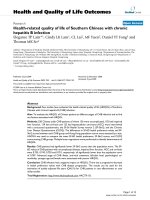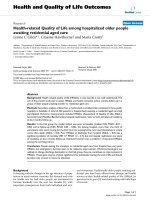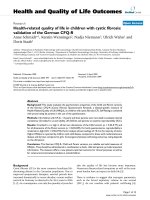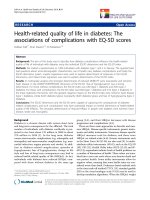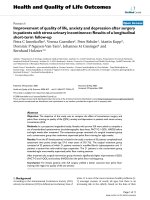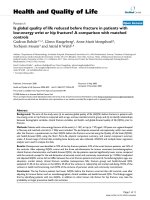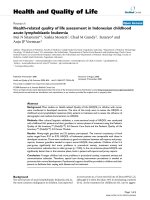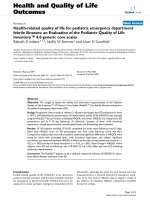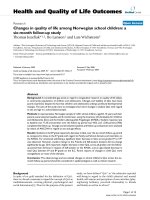báo cáo hóa học: " Mobile Air Quality Studies (MAQS)-an international project" pot
Bạn đang xem bản rút gọn của tài liệu. Xem và tải ngay bản đầy đủ của tài liệu tại đây (743.55 KB, 5 trang )
Groneberg et al. Journal of Occupational Medicine and Toxicology 2010, 5:8
/>Open Access
STUDY PROTOCOL
BioMed Central
© 2010 Groneberg et al; licensee BioMed Central Ltd. This is an Open Access article distributed under the terms of the Creative Com-
mons Attribution License ( which permits unrestricted use, distribution, and reproduc-
tion in any medium, provided the original work is properly cited.
Study protocol
Mobile Air Quality Studies (MAQS)-an international
project
David A Groneberg
1
, Cristian Scutaru*
2
, Mathias Lauks
3
, Masaya Takemura
4
, Tanja C Fischer
5
, Silvana Kölzow
6
,
Anke van Mark
7
, Stefanie Uibel
8
, Ulrich Wagner
9
, Karin Vitzthum
10
, Fabian Beck
11
, Stefanie Mache
12
, Carolin Kreiter
13
,
Bianca Kusma
14
, Annika Friedebold
15
, Hanna Zell
1
, Alexander Gerber
16
, Johanna Bock
8
, Khaled Al-Mutawakl
17
,
Johannes Donat
18
, Maria Victoria Geier
1
, Carolin Pilzner
19
, Pia Welker
20
, Ricarda Joachim
21
, Harald Bias
21
,
Michael Götting
2
, Mohannad Sakr
6,22
, Johann P Addicks
8
, Julia-Annik Börger
23
, Anna-Maria Jensen
5
,
Sonja Grajewski
1,24
, Awfa Shami
12,25
, Niko Neye
26
, Stefan Kröger
12
, Sarah Hoffmann
27
, Lisa Kloss
1
, Sebastian Mayer
28
,
Clemens Puk
1
, Ulrich Henkel
29
, Robert Rospino
1
, Ute Schilling
8
, Evelyn Krieger
18
, Gesa Westphal
12
, Andreas Meyer-
Falcke
30
, Hagen Hupperts
2
, Andrés de Roux
31
, Salome Tropp
1
, Marco Weiland
10
, Janette Mühlbach
10
,
Johannes Steinberg
1
, Anne Szerwinski
12
, Sepiede Falahkohan
6
, Claudia Sudik
32
, Anna Bircks
33
, Oliver Noga
34
,
Nicolas Dickgreber
19
, Q Thai Dinh
19
, Heiko Golpon
19
, Beatrix Kloft
35
, Rafael Neill B Groneberg
36
, Christian Witt
37
,
Sabine Wicker
38
, Li Zhang
39
, Jochen Springer
40
, Birgitta Kütting
41
, Ervin C Mingomataj
42
, Axel Fischer
35
,
Norman Schöffel
2
, Volker Unger
2
and David Quarcoo
1
Abstract
Due to an increasing awareness of the potential hazardousness of air pollutants, new laws, rules and guidelines have
recently been implemented globally. In this respect, numerous studies have addressed traffic-related exposure to
particulate matter using stationary technology so far. By contrast, only few studies used the advanced technology of
mobile exposure analysis. The Mobile Air Quality Study (MAQS) addresses the issue of air pollutant exposure by
combining advanced high-granularity spatial-temporal analysis with vehicle-mounted, person-mounted and roadside
sensors. The MAQS-platform will be used by international collaborators in order 1) to assess air pollutant exposure in
relation to road structure, 2) to assess air pollutant exposure in relation to traffic density, 3) to assess air pollutant
exposure in relation to weather conditions, 4) to compare exposure within vehicles between front and back seat
(children) positions, and 5) to evaluate "traffic zone"-exposure in relation to non-"traffic zone"-exposure.
Primarily, the MAQS-platform will focus on particulate matter. With the establishment of advanced mobile analysis
tools, it is planed to extend the analysis to other pollutants including NO2, SO2, nanoparticles and ozone.
Introduction
Air pollution is one of the major global problems [1]. It
can be defined as the emission of pollutants into the
atmosphere by natural or anthropogenic sources and dis-
plays one of the main issues in environmental medicine
[2-4]. Anthropogenic air pollution commenced with
human's systematic use of fire thousands of years ago.
Today the major sources of anthropogenic air pollution
are factory emissions, the burning of fuels and street traf-
fic. In the later, especially exhaust gases and tire abrasion
are a major problem. Currently, there is a major debate on
the impact of these traffic-related pollutants on local air
quality in the urban and also rural environment. Since
polluted air can deteriorate conditions such as asthma,
COPD or increase cardiovascular risks [1], most coun-
tries have strengthened laws to control the air quality in
the past decade. Polluted air is considered as a super-
regional problem. Therefore, international conferences
have recently developed different ways to improve and
assure air quality employing global strategic perspectives.
* Correspondence:
2
Department of Informatics, The Institute of Occupational Medicine, Charité -
Universitätsmedizin Berlin, Medical School of the Freie University Berlin and the
Humboldt-University Berlin, Berlin, Germany
Full list of author information is available at the end of the article
Groneberg et al. Journal of Occupational Medicine and Toxicology 2010, 5:8
/>Page 2 of 5
In striking contrast to the amount of research that is
currently conducted in the field of health effects [1], only
little is known on specific exposure situations.
Whereas there is a large amount of data available using
stationary systems, only little is known about the practi-
cability of mobile sensors in the assessment of air pollu-
tion.
To address this issue the authors of this protocol have
decided to establish a platform for Mobile Air Quality
Studies (MAQS). The present article describes the back-
ground and study protocol of this international project.
As primary mobile technology platform for MAQS
convertible vehicles were chosen. They offer the advan-
tage of assessing air quality in both static and mobile
modes. Within the vehicles, different positions of the
sensing modules can be also selected to monitor driver
and co-driver exposure under different settings (Fig. 1).
Secondarily, bicycle, motor bicycle and pedestrian solu-
tions will be developed.
Aims
1. To assess air pollutant exposure in relation to urban
and rural infrastructure,
2. To assess air pollutant exposure in relation to road
structure,
3. To assess air pollutant exposure in relation to traffic
density,
4. To assess air pollutant exposure in relation to
weather conditions and other outdoor air quality
parameters,
5. To assess air pollutant exposure in relation to vehi-
cle air ventilation and air condition (different set-
tings),
Figure 1 MAQS-vehicle sensing modules. Varible positions of sensors with regard to positions within the vehicle (front or back seats) and sensor
position height (adults or children height).
Groneberg et al. Journal of Occupational Medicine and Toxicology 2010, 5:8
/>Page 3 of 5
6. To assess CO
2
values in relation to particulate mat-
ter exposure,
7. To compare exposure between front and back seat
(children) positions
8. To evaluate "traffic zone"-exposure in relation to
non-"traffic zone"-exposure
9. To generate recommendations concerning the use
of the open vehicle position in relation to road struc-
ture
10. To generate recommendations concerning the use
of the open vehicle position in relation to traffic den-
sity with special regard to traffic congestion.
Methods
Monitoring
As primary technology platform, convertible vehicles will
be used. In different vehicle types, the MAQS sensing
modules will be placed. They consist of a supply unit and
an analysis unit. In the analysis unit, particulate matter
analyzers, gas analyzers (i.e. CO2, NO2, CO) and temper-
ature, humidity, anemometer etc. sensors are placed (fig.
2). An ultramobile PC unit integrates the data.
In a second step, bicycle, motor bicycle and pedestrian
solutions will be developed.
Monitoring will be carried out using convertible vehi-
cles in open and closed positions. Driving conditions will
be standardised to represent typical urban behaviours for
the different seasons of the year. Vehicles will be driven
with either open or closed windows and convertible tops,
with air-conditioning turned on or off and with varied
settings of the ventilation system. Prior to the first analy-
sis run on each route, the vehicles will be ventilated for at
least 5 minutes with open doors. The routes will be cho-
sen in different settings: "Traffic zone", motor way or sub-
urban and other urban and rural settings including
tunnels. Depending on traffic conditions, these will be
analysed and categorized differently. Data will be aver-
aged from replicates in order to provide estimates of
exposure for a distinct situation. Also, timing of the anal-
ysis routes (which may include pre-defined intermediate
waypoints or randomized routes) will be monitored by
electronic watches which are synchronised against the
different monitoring devices and GPS-systems. Also,
wind speed will be measured once on each route, using
anemometers (detection limit 0.1 m/s). The data can also
be compared to meteorologic and emission outdoor air
parameters. Referring to this, the Berlin Luftgütemessn-
etz (BLUME) may be used for studies in the German cap-
ital Berlin. The data is presented online by the
Senatsverwaltung Berlin [5] and will be analysed and
compared to the data recorded in the vehicle. Data analy-
sis and comparison will be performed using a specifically
computed software that integrates the vehicle analysis
system measurements with the BLUME measurements
[5].
In the vehicle, the analysers will be located on the back
seats to simulate the weakest passenger possible in a car:
a child. Other locations will be co-driver seats. Averaging
time for measurements will range between 1 and 60 sec-
onds, depending on the target parameter.
Public Access
A major target of MAQS is to provide public access to the
measurements. Ideally, MAQS will be used to establish
mobile sensing systems on a nation-wide and European
scale. It may be used by governmental and non-govern-
Figure 2 Schematic illustration of MAQS sensing module. The module consists of a supply unit and an analysis unit. In the analysis unit, particulate
matter analyzer, gas analyzer (i.e. CO2, NO2, CO) and temperature, humidity, anemometer sensors are placed. An ultramobile PC unit integrates the
data.
Groneberg et al. Journal of Occupational Medicine and Toxicology 2010, 5:8
/>Page 4 of 5
mental institutions for information. The analysed envi-
ronmental exposure data will be connected to GPS data
and presented in the internet.
Discussion
So far, mobile air pollutant analysing system on the basis
of convertible vehicles did not reach large scale practical
implementation. Therefore, only little data is available in
public databases such as PubMed. Previously, a number
of studies have used particulate matter analysis in closed
vehicles. In this respect, two studies assessed the expo-
sure to fine airborne particulate matter (PM
2.5
) in closed
vehicles [6,7]. It was reported that this may be associated
with cardiovascular events and increased mortality in
older and cardiac patients. Potential physiologic effects of
in-vehicle, roadside, and ambient PM
2.5
were investigated
in young, healthy, nonsmoking, male North Carolina
Highway Patrol troopers [7]. Nine troopers (age 23 to 30)
were monitored on 4 subsequent days while working a 3
P.M. to midnight shift. Each patrol car was equipped with
air-quality monitors. Blood was drawn 14 hours after
each shift, and ambulatory monitors recorded the elec-
trocardiogram throughout the shift and until the next
morning [7]. Data were analysed using mixed models. In-
vehicle PM
2.5
(average of 24 μg/m
3
) was associated with
decreased lymphocytes (-11% per 10 μg/m
3
) and
increased red blood cell indices (1% mean corpuscular
volume), neutrophils (6%), C-reactive protein (32%), von
Willebrand factor (12%), next-morning heart beat cycle
length (6%), next-morning heart rate variability parame-
ters, and ectopic beats throughout the recording (20%)
[7]. Controlling for potential confounders had little
impact on the measured effects. The correlations of these
health endpoints with ambient and roadside PM
2.5
were
smaller and less significant. The measurements in these
healthy young men suggested that in-vehicle exposure to
PM
2.5
may cause pathophysiological changes including
inflammation, coagulation and cardiac rhythm changes
[7].
Another study assessed particulate matter concentra-
tions whilst simultaneously walking and driving 48 routes
in London, UK [8]. Car trips were performed with closed
windows and the moderate ventilation system settings. It
was shown that mean exposures while walking were
greatly in excess of those while driving, by a factor 4.7 for
the coarse particle mass (PM10-PM2.5), 2.2 for the fine
particle mass (PM2.5-PM1), 1.9 for the very fine particle
mass (<PM1) and 1.4 for ultrafine particle number den-
sity [8]. It is enticing to speculate how convertible vehicle
measurements would have been. With the ability of the
MAQS-platform, this analysis can be performed in
future. The reduced in-car exposures was attributed to
the filtration system which helped to prevent ingress of
particles, so that the vehicle acted as a more-or-less inde-
pendent micro-environment, insulated against much of
air pollution present in the street [8].
In contrast to results from closed vehicles, exposure in
open vehicles has not been investigated in great detail so
far. In this respect, the present project may not only be
used as mobile traffic pollution sensor platform but also
to investigate the particulate matter exposure in open-
convertible vehicles versus closed-convertible vehicles
under a multitude of settings.
Concerning other mobile environmental sensing sys-
tems, a recent British project may be used as a bench-
mark. This project entitled Mobile Environmental
Sensing System Across Grid Environments (MESSAGE)
is a three-year research project that is funded jointly by
the British Engineering and Physical Sciences Research
Council and the British Department for Transport [9].
Besides this, MESSAGE also has the support of nineteen
non-academic organisations from public sector transport
operations, commercial equipment providers, systems
integrators and technology suppliers [9].
Beginning in October 2006, nearly 4 million EURO are
invested to develop and demonstrate the potential of
diverse, low cost sensors and to provide data for the plan-
ning, management and control of the environmental
impacts of transport activity at urban, regional and
national level in the United Kingdom. As in the MAQS-
project which focuses on Germany, MESSAGE includes
the implementation on vehicles. In addition, pedestrians
are recruited to act as mobile, real-time environmental
sensor carriers in order to sense transport and non-trans-
port related pollutants and hazards [9].
Within the project, three sensor platforms are devel-
oped: The University of Cambridge group investigates the
potential for mobile phones to support a sensing system.
The University of Newcastle develops a "smart-dust" net-
work using Zigbee (IEEE 802.15.4) motes, and the Impe-
rial College in London devises a network that utilises
WiFi (IEEE 802.11.g) and WiMax (IEEE 802.16) technolo-
gies for communications and positioning [9].
With this British project as benchmark, the MAQS-
platform is intended to provide a first mobile environ-
mental sensing system for Germany using convertible
vehicles as a new technology platform. Information and
updates on MAQS are available on the internet portal of
the Institute of Occupational Medicine of the Charité
[10].
Competing interests
The authors declare that they have no competing interests.
Authors' contributions
DAG, CS, AF, DQ, BK conceived of the study, and participated in its design and
coordination. ML, MT, TCF, SK, AvM, SU, UW, KV, FB, SM, CK, BK, AF, HZ, AG, JB,
KAM, JD, MVG, CP, PW, RJ, HB, MG, MS, JPA, JAB, A-MJ, SG, AS, NN, SK, SH, LK, SM,
CP, UH, RR, US, EK, GW, AM-F, HH, AdR, ST, MW, JM, JS, AS, SF, CS, AB, ON, ND,
Groneberg et al. Journal of Occupational Medicine and Toxicology 2010, 5:8
/>Page 5 of 5
QTD, HG, BK, RNBG, CW, SW, LZ, JS, BK, ECM, NS, VU, DQ are project partners and
participate in the conductance of the study. All authors read and approved the
final manuscript.
Acknowledgements
This project is supported by EUGT (research grant) and by Grimm Aerosol Tech-
nik (technical equipment).
Author Details
1
Department of Environmental and Traffic Medicine, The Institute of
Occupational Medicine, Charité - Universitätsmedizin Berlin, Medical School of
the Freie University Berlin and the Humboldt-University Berlin, Berlin, Germany
,
2
Department of Informatics, The Institute of Occupational Medicine, Charité -
Universitätsmedizin Berlin, Medical School of the Freie University Berlin and the
Humboldt-University Berlin, Berlin, Germany,
3
Fachhochschule Senftenberg,
Senftenberg, Germany,
4
Respiratory Disease Center, Kitano Hospital, Osaka,
Japan,
5
Laser Centre, Potsdam, Germany,
6
Department of Allergy, The Institute
of Occupational Medicine, Charité - Universitätsmedizin Berlin, Medical School
of the Freie University Berlin and the Humboldt-University Berlin, Berlin,
Germany,
7
Institute of Occupational Medicine, University of Lübeck, Lübeck,
Germany,
8
Department of Toxicology, The Institute of Occupational Medicine,
Charité - Universitätsmedizin Berlin, Medical School of the Freie University
Berlin and the Humboldt-University Berlin, Berlin, Germany,
9
Chest Hospital
Löwenstein, Löwenstein, Germany,
10
Department of Sports Medicine, The
Institute of Occupational Medicine, Charité - Universitätsmedizin Berlin,
Medical School of the Freie University Berlin and the Humboldt-University
Berlin, Berlin, Germany,
11
Pariser Street Outpatient Clincis, Berlin, Germany,
12
Department of Health Management, The Institute of Occupational Medicine,
Charité - Universitätsmedizin Berlin, Medical School of the Freie University
Berlin and the Humboldt-University Berlin, Berlin, Germany,
13
Chest
Department Heckeshorn, Helios-Emil-von-Behring-Hospital, Berlin, Germany,
14
Department of Occupational Psychology, The Institute of Occupational
Medicine, Charité - Universitätsmedizin Berlin, Medical School of the Freie
University Berlin and the Humboldt-University Berlin, Berlin, Germany,
15
Department of Surgery, Helios-Emil-von-Behring-Hospital, Berlin, Germany,
16
Rheumaklinik Berlin-Buch, Berlin, Germany,
17
Faculty of Medicine, University
of Sanaa, Yemen,
18
Ruppiner Kliniken, Neuruppin, Germany,
19
Department of
Respiratory Medicine, Centre of Medicine, Medizinische Hochschule Hannover,
Hannover, Germany,
20
Department of Cell Biology, Mivenion Inc., Berlin,
Germany,
21
AMZ, Charité - Universitätsmedizin Berlin, Berlin, Germany,
22
Al-
Assaf University Hospital, Lattakia, Syria,
23
General Hospital, Freising, Germany,
24
Department of Oral and Maxillofacial Surgery, Charité - Universitätsmedizin
Berlin, Medical School of the Freie University Berlin and the Humboldt-
University Berlin, Berlin, Germany,
25
Faculty of Medicine, Tishreen University,
Lattakia, Syria,
26
Department of Medicine, Park-Klinik Weissensee, Berlin,
Germany,
27
Department of Neurology, Charité - Universitätsmedizin Berlin,
Medical School of the Freie University Berlin and the Humboldt-University
Berlin, Berlin, Germany,
28
Department of Surgery, Dominikus-Hospital, Berlin,
Germany,
29
Occupational Medicine, TUV, Berlin, Germany,
30
Strategy Centre for
Health, Health Care Campus North Rhine Westphalia, Bochum, Germany,
31
Chest Clinics Charlottenburg, Berlin, Germany,
32
Unfallkrankenkaus Marzahn,
Berlin, Germany,
33
Hospital Luckenwalde, Luckenwalde, Germany,
34
Institute
for Allergy and Asthma Research, Berlin, Germany,
35
Otto-Heubner-Centre,
Charité - Universitätsmedizin Berlin, Medical School of the Freie University
Berlin and the Humboldt-University Berlin, Berlin, Germany,
36
Faculty of
Biology, University of Mainz, Mainz, Germany,
37
Department of Medicine,
Charité - Universitätsmedizin Berlin, Medical School of the Freie University
Berlin and the Humboldt-University Berlin, Berlin, Germany,
38
Occupational
Medicine Service, University of Frankfurt, Frankfurt, Germany,
39
Fujian First
College of Medicine, Fujian, PR China,
40
Division of Applied Cachexia Research
and Center for Cardiovascular Research, Charité-Universitätsmedizin Berlin,
Medical School of the Freie University Berlin and the Humboldt-University
Berlin, Berlin, Germany,
41
Institute and Outpatient Clinic of Occupational, Social
and Environmental Medicine, University of Erlangen- Nuremberg, Erlangen,
Germany and
42
Dept of Allergology & Clinical Immunology, Mother Theresa
School of Medicine, Tirana, Albania
References
1. Groneberg DA, Morfeld P, Kraus T, Kohler D, Krug N, Magnussen H, Nowak
D, Rabe KF, Schultze-Werninghaus G, Schulz H, et al.: Health effects of
particulate matter exposure: current scientific knowledge.
Pneumologie 2009, 63:363-368.
2. Sierra-Vargas MP, Guzman-Grenfell AM, Blanco-Jimenez S, Sepulveda-
Sanchez JD, Bernabe-Cabanillas RM, Cardenas-Gonzalez B, Ceballos G,
Hicks JJ: Airborne particulate matter PM2.5 from Mexico City affects the
generation of reactive oxygen species by blood neutrophils from
asthmatics: an in vitro approach. J Occup Med Toxicol 2009, 4:17.
3. Groneberg DA, Witt C: Air quality and particulate matter. Pneumologie
2005, 59:607-611.
4. Just N, Duchaine C, Singh B: An aerobiological perspective of dust in
cage-housed and floor-housed poultry operations. J Occup Med Toxicol
2009, 4:13.
5. Berlin State Department of Health, Environment and Consumer
Protection [ />5.htm]
6. Riediker M: Cardiovascular effects of fine particulate matter
components in highway patrol officers. Inhal Toxicol 2007, 19(Suppl
1):99-105.
7. Riediker M, Devlin RB, Griggs TR, Herbst MC, Bromberg PA, Williams RW,
Cascio WE: Cardiovascular effects in patrol officers are associated with
fine particulate matter from brake wear and engine emissions. Part
Fibre Toxicol 2004, 1:2.
8. Briggs DJ, de Hoogh K, Morris C, Gulliver J: Effects of travel mode on
exposures to particulate air pollution. Environ Int 2008, 34:12-22.
9. Mobile Environmental Sensing System Across Grid Environments
(MESSAGE) [ />10. Mobile Air Quality Studies (MAQS) [ />arbeitsmedizin/Maqs/index.html]
doi: 10.1186/1745-6673-5-8
Cite this article as: Groneberg et al., Mobile Air Quality Studies (MAQS)-an
international project Journal of Occupational Medicine and Toxicology 2010,
5:8
Received: 27 November 2009 Accepted: 9 April 2010
Published: 9 April 2010
This article is available from: 2010 Groneberg et al; licensee BioMed Central Ltd. This is an Open Access article distributed under the terms of the Creative Commons Attribution License ( ), which permits unrestricted use, distribution, and reproduction in any medium, provided the original work is properly cited.Journal of Occupational Medicine and Toxicology 2010, 5:8
